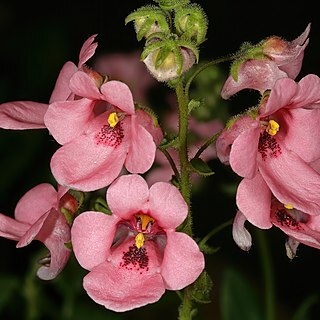Stoloniferous perennial herb, stems many from the crown, tufted, branching, up to c. 500 mm long c. 2 mm diam., decumbent or suberect, often straggling, nearly glabrous to sparsely glandular-pilose, the hairs patent. Leaves either glabrous or thinly glandular-pilose, mostly 15-50 x 10-35 mm (ratio 1-2:1), ovate or ovate-lanceolate, apex subacute, base ± rounded, margins sharply serrate, petiole 2-10 mm long, glabrous or glandular-hairy. Flowers few to many in lax terminal racemes; bracts up to 12 x 10 mm, but mostly much smaller, ovate-lanceolate, very acute to shortly acuminate, thinly glandular-pilose; pedicels mostly 14-25 mm long, sharply ascending, thinly glandular-pilose, the hairs c. 0.5 mm long. Calyx segments spreading, lanceolate, two anticous segments 3.5-5 x 1.75-2 mm, three posticous ones slightly smaller, all green with spreading gland-tipped hairs outside. Corolla tube c. 5-6 mm long, scarcely invaginated, two lateral spurs c. (6-)7-9 mm long, curved out, down and slightly forward, with a patch of dark sessile glands within, limb c. 22-28 x 17-23 mm, anticous lobe elliptic-ovate, 10-13 x 11-15 mm, two lateral lobes subrotund or elliptic-oblong, 5-7 x 7-8.5 mm, two posticous lobes subrotund or elliptic-oblong, 4.5-7 x 4.5-6, all rose-pink, sparsely glandular-pilose outside, inside with a broad inverted V of dark sessile glands centrally placed on the raised palate, very rarely these glands wanting, the “window” concave, c. 1-1.5 mm deep, yellow and maroon. Stamens projecting forward; filaments 3 mm long, sparsely glandular-pubescent in the upper half, anthers 1-1.5 mm long, cohering strongly, pollen yellow. Ovary 1.5-2 x 1-1.25 mm, deltoid in outline; ovules many in each loculus; style c. 2 mm long, stigma capitate, emerging from the centre of the anthers. Capsules (6-)7-11 mm long, urceolate; seeds 1.25 mm long, curved, winged and ridged.
More
Perennial herb, up to 0.5 m high. Stems decumbent or suberect, stoloniferous, tufted branches from base. Leaves with blade ovate to ovate-lanceolate, 15-50 x 10-35 mm, apex subacute, base rounded, margins serrate, glabrous to glandular-hairy; petioles 2-10 mm long. Flowers: in lax racemes, 14-20 x 12-18 mm; pedicels with hairs at least 0.5 mm long; styles ± 2 mm long; calyx lobes spreading; spurs lateral, 6-9 mm long, curved out, down and slightly forward; corolla tube 5-6 mm long, rounded lobes, lobes mostly pale pink to salmon-coloured, dark gland dots cover mouth, window yellow and maroon; Nov.-Apr.

